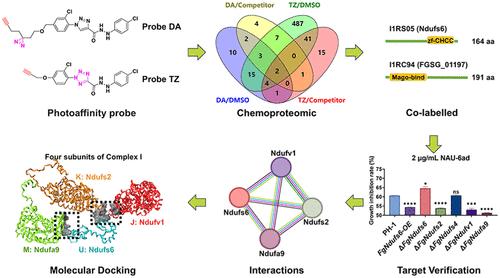基于竞争亲和力的蛋白质分析揭示了 1,2,3-三唑肼在禾谷镰刀菌中的潜在抗真菌靶标
IF 6.2
1区 农林科学
Q1 AGRICULTURE, MULTIDISCIPLINARY
引用次数: 0
摘要
在前人的研究中,1,2,3-三唑肼NAU-6ad表现出显著的广谱抗真菌活性。然而,NAU-6ad的具体目标仍然未知。最初,我们排除了三个靶标─琥珀酸脱氢酶、漆酶和麦角甾醇合成酶──它们通常与文献中提到的肼衍生物相关。随后,我们开发了两种类型的光探针:一种含有二氮嘧啶(DA),另一种含有苯基四唑(TZ),两者都具有用于生物正交反应的末端炔。使用这两组探针,通过基于竞争亲和力的蛋白质组分析,共鉴定了52个潜在靶点。值得注意的是,Ndufs6和I1RC94被两组一致地识别出来。Ndufs6(复合体I的一个亚基)的过表达或敲除导致F. graminearum对NAU-6ad的敏感性发生显著变化。同样,敲除复合体I的其他亚基,特别是Ndufs2、Ndufv1和Ndufa9,改变了F. graminearum对NAU-6ad的敏感性,表明NAU-6ad可能对复合体I起作用。酶活性测试、ATP含量测定、丙酮酸添加测定和分子对接进一步验证了NAU-6ad可能作为复合体I抑制剂的假设。本文章由计算机程序翻译,如有差异,请以英文原文为准。

Competitive Affinity-Based Protein Profiling Reveals Potential Antifungal Targets of 1,2,3-Triazole Hydrazide in Fusarium graminearum
In previous research, 1,2,3-triazole hydrazide NAU-6ad exhibited remarkable broad-spectrum antifungal activity. However, the specific targets of NAU-6ad remained unknown. Initially, we excluded three targets─succinate dehydrogenase, laccase, and ergosterol synthase─commonly associated with hydrazide derivatives mentioned in the literature. Subsequently, we developed two types of photoprobes: one incorporating diazirine (DA) and the other phenyl tetrazole (TZ), both featuring terminal alkynes for bioorthogonal reactions. Using these two sets of probes, a total of 52 potential targets were identified through competitive affinity-based proteome profiling. Notably, Ndufs6 and I1RC94 were consistently identified by both sets. The overexpression or knockout of Ndufs6, a subunit of complex I, led to significant changes in sensitivity to NAU-6ad in F. graminearum. Similarly, the knockout of other subunits of complex I, specifically Ndufs2, Ndufv1, and Ndufa9, altered the sensitivity of F. graminearum to NAU-6ad, indicating that NAU-6ad might act upon complex I. Further validation was provided by enzyme activity tests, ATP content assays, pyruvate addition assays, and molecular docking, collectively reinforcing the hypothesis that NAU-6ad might function as a complex I inhibitor.
求助全文
通过发布文献求助,成功后即可免费获取论文全文。
去求助
来源期刊
CiteScore
9.90
自引率
8.20%
发文量
1375
审稿时长
2.3 months
期刊介绍:
The Journal of Agricultural and Food Chemistry publishes high-quality, cutting edge original research representing complete studies and research advances dealing with the chemistry and biochemistry of agriculture and food. The Journal also encourages papers with chemistry and/or biochemistry as a major component combined with biological/sensory/nutritional/toxicological evaluation related to agriculture and/or food.

 求助内容:
求助内容: 应助结果提醒方式:
应助结果提醒方式:


